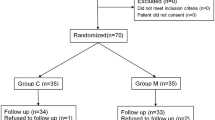Abstract
The effects of magnesium sulfate (MgSO4) as a preanesthetic medication were studied with regard to whether it can sedate or relieve a patient who is scheduled to undergo surgery, and whether it can control the hemodynamic response to tracheal intubation. Twenty adult patients in ASA status 1–2 undergoing elective surgery were studied. Ten patients received 50 mg·g−1 MgSO4 intravenously by drip infusion from 30 min before the induction of anesthesia, and another ten patients received saline as a control. The changes in mean arterial pressure (MAP) and rate pressure product (RPP) after the intubation were significantly suppressed in magnesium-treated patients, but a sedative effect was not observed. Therefore, MgSO4 was useful as a preanesthetic medication in suppressing the hemodynamic response associated with tracheal intubation.
Similar content being viewed by others
References
James MFM (1992) Clinical use of magnesium infusions in anesthesia. Anesth Analg 74:129–136
Altura BM, Altura BT, Carella A, et al. (1987) Mg2+−Ca2+ interaction in contractility of vascular smooth muscle: Mg2+ versus organic calcium channel blockers on myogenic tone and agonist-induced responsiveness of blood vessels. Can J Physiol Pharmacol 65:729–745
Altura BM (1988) Ischemic heart disease and magnesium. Magnesium 7:57–67
Meltzer SJ, Auer J (1906) Physiological and pharmacological studies of magnesium salts. Am J Physiol 15:387–405
Peck CH, Meltzer SJ (1916) Anesthesia in human beings by intravenous injection of magnesium sulphate. JAMA 67:1131–1133
Moore RM, Wingo WJ (1942) Blood level of magnesium ion in relation to lethal, anesthetic, analgesic and antitetanic effects. Am J Physiol 135:492–495
Thompson SW, Moscicki JC, DiFazio CA (1988) The anesthetic contribution of magnesium sulfate and ritodrine hydrochloride in rats. Anesth Analg 67:31–34
Gutsche BB, Cheek TG (1987) Anesthetic considerations in preeclampsia-eclampsia. In: Shnider SM (ed) Anesthesia for Obstetrics. Williams and Wilkins, Baltimore, p 230
Iseri LT, Allen BJ, Brodsky MA (1989) Magnesium therapy of cardiac arrhythmias in critical care medicine. Magnesium 8:299–306
James MFM (1985) The use of magnesium sulfate in the anesthetic management of pheochromocytoma. Anesthesiology 62:188–190
James MFM, Beer RE, Esser JD (1989) Intravenous magnesium sulfate inhibits catecholamine release associated with tracheal intubation. Anesth Analg 68:772–776
Zaloga G, Eisenach JC (1991) Magnesium, anesthesia, and hemodynamic control. Anesthesiology 74:1–2
Cohen L, Kitzes R (1984) Magnesium sulfate in the treatment of variant angina. Magnesium 3:46–49
Aldrete JA (1987) Magnesium physiology and pharmacology in anesthesia. Anesthesiol Rev 14:33–39
Author information
Authors and Affiliations
About this article
Cite this article
Kagawa, T., Goto, R., Iijima, K. et al. Intravenous magnesium sulfate as a preanesthetic medication: A double-blind study on its effects on hemodynamic stabilization at the time of tracheal intubation. J Anesth 8, 17–20 (1994). https://doi.org/10.1007/BF02482746
Received:
Accepted:
Issue Date:
DOI: https://doi.org/10.1007/BF02482746




